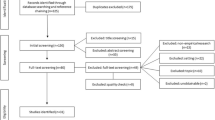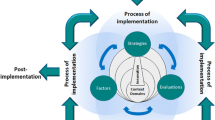Abstract
Objective To develop, apply and evaluate a new research method to establish relationships between structural and process elements of the provision of cognitive services. In-depth knowledge about how local organisational structural elements of community pharmacies shape the implementation process of cognitive services is needed to develop targeted quality assurance systems to ensure that the services are continuously provided to the patients who need them. The first publicly reimbursed cognitive service in Denmark, the Inhaler Technique Assessment Service (ITAS) is used as the case. Setting The research method was developed at the Faculty of Pharmaceutical Sciences at the University of Copenhagen and later applied to seven community pharmacies geographically spread around Denmark. Methods A pilot study as well as a subsequent literature review was conducted to determine which structure–process elements to focus on in the research method as well as to select appropriate theories and methods. Results The developed research method was a qualitative exploratory multi-case study, that was based on method triangulation of field observations, semi-structured interviews, group interviews as well as collection of documentary material. The three main themes of the research method were: the administration of tasks, leadership style and professional values. We integrated the organisational theories of Mintzberg, Bolman and Deal as well as Sørensen to support and clarify the data collection process and analyses. A cross-case analysis and an exploratory contextual analysis relating the leadership style of the pharmacy owner to the ITAS provision were applied to the collected data. Conclusion The developed qualitative exploratory multi-case study research method was satisfactory with regard to achieving nuanced and in-depth results of some relationships between structural and process elements of provision of cognitive services. The research method can be considered an important supplement to the existing literature on the sustainability of cognitive services.

Similar content being viewed by others
References
Bellingham B. What the new contract has in store. Pharm J. 2004;273:385.
Costa S, Santos C, Silveira J. Community pharmacy services in Portugal. Ann Pharmacother. 2006;40(12):2228–34.
Eickhoff C, Schulz M. Pharmaceutical care in community pharmacies: practice and research in Germany. Ann Pharmacother. 2006;40:729–35.
Kaae S, Traulsen JM, Søndergaard B, Haugbølle LS. The relevance of political pre-studies for implementation studies of cognitive services in community pharmacies. Res Soc Adm Pharm. 2009;5:189–94.
Mainz J. Defining and classifying clinical indicators for quality improvement. Int J Qual Health Care. 2003;15:523–30.
Donabedian A. The quality of care—how can it be assessed? JAMA. 1988;260(12):1743–8.
Thomsen MH, Bolvig T, Damsø LB et al. Pseudo customers in Danish pharmacies. Presented at reengineering pharmacy practice in a changing world. 68th International Congress of FIP; 2008 August 29–September 4; Basel, Switzerland.
Barnes JM, Rielinger JE, McCloskey WW, Montagne M. Barriers to compliance with OBRA’90 regulations in community pharmacy. Ann Pharmacother. 1996;30:1101–5.
Kröger E, Moisan J, Gregoire J-P. Billing for cognitive services. Ann Pharmacother. 2000;34:309–16.
Murphy AL, MacKinnon NL, Flanagan PS, Bowles SK, Sketris IS. Pharmacists’ participation in an inhaled respiratory medication program: reimbursement of professional fees. Ann Pharmacother. 2005;39:655–61.
Gastelurrutia MA, Benrimoj SI, Castrillon CC, Casado de Amezua MJ, Fernadez-Llimos F, Faus MJ. Facilitators for practice change in Spanish community pharmacy. Pharm World Sci. 2008;31(1):32–9.
Hopp TR, Sørensen EW, Herborg H, Roberts AS. Implementation of cognitive pharmaceutical services (CPS) in professionally active pharmacies. Int J Pharm Pract. 2005;13:21–31.
Kennedy DT, Small RE. Development and implementation of a smoking cessation clinic in community pharmacy practice. J Am Pharm Assoc (Wash). 2002;42(1):83–92.
Pinto SL, Morgan EE. Preparing pharmacists for medication therapy management services: designing and implementing a pharmacist-run diabetes management program in a community setting. Manag Care Interface. 2007;20:52–6.
Pronk MCM, Blom LTG, Jonkers R, Van Burg A. The diffusion process of patient education in Dutch community pharmacy: an exploration. Patient Educ Couns. 2001;42(2):115–21.
Roberts AS, Hopp TR, Sørensen EW, Benrimoj SI, Chen TF, Herborg H, et al. Understanding practice change in community pharmacy: a qualitative research instrument based on organisational theory. Pharm World Sci. 2003;25(5):227–34.
Doucette WR, Jambulingam T. Pharmacy entrepreneurial orientation: antecedents and it’s effect on the provision of innovative pharmacy services. J Soc Admin Pharm. 1999;16(1):26–37.
Iyer S, Doucette WR. The influence of environmental attributes on the relationship between entrepreneurial orientation and performance in independent community pharmacies. J Pharm Mark Manage. 2003;15(2):25–46.
Doucette WR, Koch YDS. An exploratory study of community pharmacy practice change. J Am Pharm Assoc (Wash). 2000;40(3):384–91.
Vrangbæk K, Tryggestad K, Borum F. Organisationen, chapter 5, p. 66–95 in Metodehåndbog for Medicinsk Teknologivurdering. København, Statens Institut for Medicinsk Teknologivurdering; 2000. ISBN:9-7887-7676-620-7.
Klinke BO, Fonnesbæk L. [Tjek på inhalation - afprøvning af ydelsen. Evalueringsrapport]. Pharmakon; Hillerød, Denmark, 2005.
Bogason P, Sørensen E. Samfundsforskning Bottom-up. Roskilde. Roskildes Universitetsforlag; 1998. ISBN:8-7786-7046-2.
Roberts AS, Benrimoj SI, Chen TF, Williams KA, Aslani P. Implementing cognitive services in community pharmacy: a review of facilitators used in practice change. Int J Pharm Pract. 2006;14:163–70.
Blekinsopp A, Bond C, Celino G et al. National evaluation of the new pharmacy contract. Executive summary. London: The Pharmacy Practice Research Trust; 2007.
Capurso KA, Powers MF. Barriers to implementing a pharmacists-run immunization service, as perceived by pharmacists, in a community pharmacy chain. J Pharm Technol. 2006;22:91–4.
Carter BL, Chrischilles EA, Scholz D, Hayase N, Bell N. Extent of services provided by pharmacists in the Iowa medicaid pharmaceutical case management program. J Am Pharm Assoc (Wash). 2003;43:24–33.
Fedder DO, Levine DL, Patterson Russell R, Lewis C, Lamy PP. Strategies to implement a patient counseling and medication tickler system—a study of Maryland pharmacists and their hypertensive patients. Patient Educ Couns. 1998;11:53–64.
Lopatka H, Bachynsky J. Evaluation of a community pharmacy reimbursement model for cognitive services—experiment and survey. J Pharmaceut Finance, Econ Pol. 2004;13:69–95.
MacKeigan LD, Marshman JA, Kruk-Romanus D, Milovanovic DA, Jackevicius C, Naglie G, et al. Clinical pharmacy services in the home: Canadian case studies. J Am Pharm Assoc (Wash). 2002;42(5):735–42.
McAnaw JJ, McGregor AM, Hudson SA. The pharmaceutical care of patients with hypertension: an examination of service models in primary care in US. Pharm World Sci. 2001;23:189–94.
Pronk MCM, Blom LTG, Jonkers R, Bakker A. Effects of a management technician on structures working in Dutch community pharmacies. Pharm World Sci. 2004;26:221–6.
Roberts AS, Benrimoj SI, Chen TF, Williams KA, Hopp TR, Aslani P. Understanding practice change in community pharmacy: a qualitative study in Australia. Res Social Adm Pharm. 2005;1(4):546–64.
Saini B, Krass I, Armour C. Specialisation in asthma: current practice and future roles—a qualitative study of practising community pharmacists. J Soc Admin Pharm. 2001;18:169–77.
Sias JJ, Bennett MS. A reimbursable education service for patients with hepatitis C. J Am Pharm Assoc (Wash). 2001;41:448–53.
Flick U. An introduction to qualitative research. London: Sage Publications, Inc.; 2002. ISBN:0-7619-5588-7.
Yin RK. Case study research: design and methods. Thousand Oaks: Sage Publications; 2003. ISBN:0-7619-2553-8.
Bolman LG, Deal TE. Reframing organizations—artistry, choice and leadership. San Francisco: Jossey-Bass; 2003. ISBN:0-7879-6426-3.
Sørensen EW. The pharmacist’s professional self-perception—a model for the pharmacist’s professional self-perception and an evaluation of the pharmacist’s possibilities to initiate tasks in the primary health care. J Soc Admin Pharm. 1986;3(4):144–56.
Sørensen EW, Winther L. [Implementering af farmaceutisk omsorg i skranken på Brønshøj Apotek - del 2: opfattelser af farmaceutisk omsorg blandt personalet på Brønshøj Apotek]. Hillerød, København, Denmark: Danmarks Farmaceutiske Højskole & Pharmakon A/S; 1999.
Mintzberg H. Structures in fives—designing effective organizations. NJ: Prentice Hall International Editions; 1986. ISBN:0-1385-4191-4.
Kvale S. Interviews: an introduction to qualitative research interviewing. London: Sage Publications; 1996. ISBN:0-8039-5820-x.
Hopp TR, Klinke BO, Sørensen EW, Herborg H, Roberts A. Implementation of cognitive pharmaceutical services in Danish community pharmacies—perceptions of strategists and practitioners. Int J Pharm Pract. 2006;14:37–49.
Klinke BO. Ledelse og organisation på de danske apoteker [thesis]. København, Denmark: Det Farmaceutiske Fakultet, Københavns Universitet; 2008.
Funding
The project was funded by the Faculty of Pharmaceutical Sciences, University of Copenhagen, Denmark as part of a PhD study.
Conflict of interest
The authors have no interest of conflict to declare.
Author information
Authors and Affiliations
Corresponding author
Rights and permissions
About this article
Cite this article
Kaae, S., Søndergaard, B., Haugbølle, L.S. et al. Development of a qualitative exploratory case study research method to explore sustained delivery of cognitive services. Pharm World Sci 32, 36–42 (2010). https://doi.org/10.1007/s11096-009-9337-5
Received:
Accepted:
Published:
Issue Date:
DOI: https://doi.org/10.1007/s11096-009-9337-5




